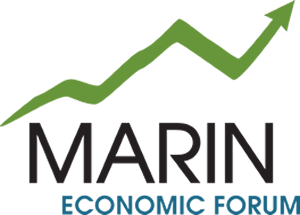2024 economic outlook for Marin County a positive one
Inflation and the high cost of living still top the list of major concerns consumers face today in the wake of tight monetary policy. But this is already beginning to change with lower prices for appliances, gasoline, furniture, and used cars — as well as due to the possibility of interest rate cuts affecting borrowing costs coming into view. At the same time, the labor market remains strong, calming fears of a pending recession.
The state of the national and local economy was the topic at December’s Marin Economic Forum. The forum is designed to recap 2023 and offer a preview of what to watch for in 2024. Economic Forum CEO Mike Blakeley hosted the online briefing and introduced Sonoma State University Economist Dr. Robert Eyler who provided an overview of current realities while also offering a cautious, but positive forecast for the year ahead.
High inflation may soon start to fade for Americans in 2024 after the Federal Reserve announced Dec. 13 that it would hold steady the current rate set in July and hinted that rates could be cut three times next year — after raising rates 11 times since March 2022.
“Before the recent Fed announcement we saw a lot of disagreement between different groups,” said Blakeley. “For example, The Economist reported in December that four of the largest investment banks have different perceptions for economic growth what will happen in 2024 ranging from 1% to 2.5%. Very strong economic growth is from 2 — 3%. That range of disagreement is interesting. It underscores no one really knows but everyone has an opinion. These estimates will probably change when rates decline.”
Labor Market Strength
According to Eyler, “Job growth continues. The labor market’s continuing strength is the main reason why we have not had a declared recession in the U.S. since the original shock of the pandemic. Today the labor market is expanding from its pre-pandemic peak and is about 3.3% above the January 2020 seasonally adjusted data for the number of people working in the U.S.”
Eyler said it is important to keep in mind what the Federal Reserve is considering when thinking about increasing or decreasing interest rates.
“While the labor market is increasing 3.3%, it is increasing at a decreasing rate, which means this line on a chart is starting to get a little flatter. In addition, the Federal Reserve also wants to see job growth in the U.S. fade a little bit, and for the most part that decline has also started.”
He said, “When we see a strong labor market start to slow, in a sense this speeds-up a drop toward the longer-term inflation expectations level.”
At the same time Eyler said more people living in Marin County are working from home (25.9% in 2022) the second highest rate in the state compared with 13.6% for all of California.
The transition between a hotter job market and higher inflation, to a flatter job market and lower inflation is really what the Federal Reserve has been trying to craft with higher interest rates, Eyler stated. “The game is how much of that job downturn, if it materializes, will ultimately move the entire economy closer to recession.”
“Today the labor market remains relatively warm, and without some coldness coming into this market, we will not have a declared recession in the U.S. anytime soon. We have seen prices dropping. But Consumer Price Index data came out suggesting that we are still on track to get back down to what you could think of as the inflation level the Federal Reserve would like to see.”
Core Personal Consumption Prices
Eyler said the Consumer Price Index is not necessarily the price index that the Federal Reserve is watching. “When thinking about policy, the Federal Reserve watches the Core Personal Consumption Expenditure Price Index a measure of consumer spending except for food and energy products and services.”
For most of the time to October 2023 this indicator (the price of that inflation rate representing the percentage change from 12 months previous), stayed near the 2% base line from 2007 to 2021 but shot up to above the 5% level in 2022 for 7-8 months — coming down to 3.5% last October. This was comparable to October 2022 prices for what consumers buy at home, Eyler said.
“What the Federal Reserve is trying to do is shape how financial and labor markets think about inflation and ultimately how we think about it at home by taking steps to adjust the ups and downs of the Core PCE long-term inflation rate by bringing it closer to the 2% level considered to define long-term inflation expectations, which at least for this year is going a little faster than they expected,” Eyler added.
What to Watch in 2024
Eyler identified four key things to watch for next year in the Bay Area and San Francisco:
1. Interest rates are predicted to fall. Watch for a possible rate cut(s) in Q2 or Q3 (perhaps as early as March) as the Federal Reserve shifts to the next phase, and also how long-term rates are adjusting to the relatively high inflation rates — even though they are not as high as a year ago, but still higher than the past 15 or 16 years.
For the present, Central Bank officials said in December that interest rates would remain unchanged in a range from 5.25% to 5.5% and could be reduced next year by 0.75% lowering the rate to 4.5%. The long-term Federal Reserve goal is to keep the national inflation rate at about 2% per year.
If the Federal Reserve is going to start lowering interest rates, that will reshape the so-called yield curve or basically what lenders get for the next dollar they lend in terms of profitability.
2. There are continued concerns around commercial real estate, especially in San Francisco. Watch the news closely for certain buildings going back to lenders, more pressure on occupancy rates and what that means in secondary and tertiary markets around major office spaces in the city as well as the slow devolution in other city businesses while a medium to long term adjustment takes place. This could ripple into Marin County.
3. State and federal/presidential elections: Business investment stasis. At issue is how much the uncertainty around the presidential election might keep businesses from making expansion decisions during a period with relatively higher interest rates. This is another reason why we’re seeing a slower growth forecast for next year.
4. There is continued concern over housing. Keep an eye on construction and building permits. Talks continue in city and county chambers about the need for housing. “This is not changing and will continue. Marin County construction was strong over last year, but we will watch closely as we get closer to the end of the decade to see how much concern exists over housing in Marin County and throughout the North Bay,” Eyler said.
Marin County’s housing forecast is down 4.1% after a three-year run about 25% growth at the median based on a percentage change from October 2023 to October 2024.
While most job data for Marin industries shows declines, recovery from pre-pandemic levels has been seen in private education and health services (+4.3%), information (+7.4%), construction (+9.5%), and especially leisure and hospitality (+10.4%). While California hospitality jobs have also picked up, Marin County is seeing more tourist activity post-pandemic as people traveled more regionally.
The Federal Reserve Bank of Philadelphia’s Forecast based on a survey of 40 professional forecasters suggest a softer inflation picture in the next two years based on new projections. tn
This forecast estimated that gross domestic product (GDP) for the U.S. in 2024 will increase from 1.3% to 1.7%; while the unemployment rate will increase from 4.0% to 4.1% and Core PCE Inflation will remain steady at 2.4% — very close to the Federal Reserve target for U.S. inflation.
“All these data point to a relatively optimistic outlook for the next couple of years,” Eyler said. “The resiliency in the American economy, even on the midst of so-called relatively high interest rates has been very intriguing for economists across the board because we really expected some contraction due to the rolling window of pain we have endured. There’s been a lot of confusion in the marketplace and with political issues. Federal Reserve interest rate reductions next year could lead to a very positive outcome.”
Be the first to receive updates and news from MEF by subscribing or liking us on our social media pages: Facebook, Twitter, and LinkedIn!
Tags: news














